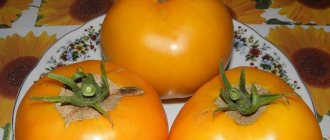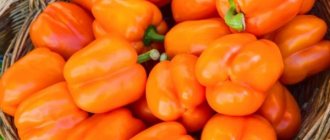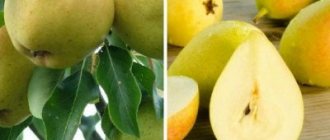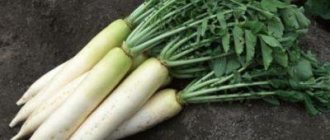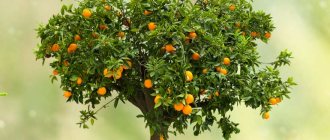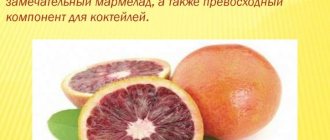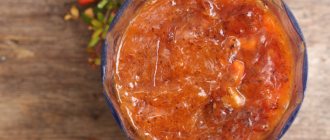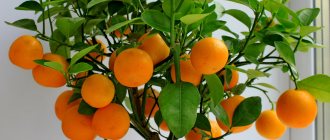What is this fruit
The bloody variety is a mutation of the common orange. The appearance of the red color due to the presence of anthocyanins is explained by the proximity of Mount Etna and the climate of the natural area where this crop is found.
Based on the area where it grows, there is another name for this unusual crop - Sicilian orange.
There are mainly three varieties:
- Orange Tarocco. The skin of this type of fruit is thin. It has an orange color with a slight reddish tint. The sweet orange-red juicy pulp is valued for its pleasant, pronounced aroma of ripe fruits. It contains practically no seeds.
- Orange Moro. This variety has a rich bloody tone. It has the most intense orange aroma and sweet taste with a light raspberry bouquet.
- Orange Sanguinello. The ripening period of this variety of citrus crop with orange peel and sweet, delicate pulp is quite short. It falls at the end of February - beginning of March.
Popular varieties
There are 3 varieties on sale : Tarocco, Moro, Sanguinello. Each of them is unique.
Tarocco comes from Italy . It is believed that the name comes from the cry of an astonished farmer who first discovered this variety. Tarocco is very popular in Italy.
Red orange "Tarokko"
The fruit has a thin orange skin with a faint red tone. This is the sweetest variety of king, and the pulp contains a minimum number of seeds . The fruits are round and medium. The pulp is juicy, reddish-orange. The taste is sweet and sour, the aroma is berry. The historical homeland of the variety is the foot of the Etna volcano. The region's fertile soil gives Tarocco its unique flavor. The fruit contains more ascorbic acid than other citrus fruits.
Reference. Biologists suggest that it occurred as a result of a mutation of Sanguinello, otherwise it is called “half-breed” due to the fact that the flesh does not have such pronounced red pigmentation as that of Sanguinello and Moro.
Sanguinello is a Spanish ancient variety of kinglet . The fruits are elongated, the peel is orange, with red splashes. The variety is late-ripening, harvested at the end of March. The flesh color ranges from dark orange, with bright red streaks, to purple-black, and the fruit contains few seeds.
Orange "Sanguinello"
Moro is a new variety that appeared in the 19th century on the island. Sicily . The fruit is oval, the peel is orange, with a wine blush. The diameter of citrus fruits is 5–8 cm, weight is 150–180 g. The pulp is juicy burgundy-red, almost without seeds, and if you come across them, they are small and soft. The taste is sweet, rich, with raspberry notes, and the aroma is strong and recognizable.
Orange "Moro"
Origin
Under natural conditions, an orange with red flesh was first discovered in Sicily. Nowadays, unusually colored and very tasty fruits are grown in China and the USA. They are also cultivated in Morocco and Spain.
This is how fruits grow on a tree branch
It is believed that the bloody fruit accumulates its unusual pigment as a result of the saturation of the soil with mineral elements formed during volcanic activity. Another important condition is the sharp contrast between night and day temperatures.
Crown features
The size of the tree is average, sometimes even below average. The shape of the crown is round, wide, the branches tend to grow to the sides, which creates certain inconveniences when kept indoors. The plant is relatively frost-resistant and can withstand short-term cold snaps down to minus 5 °C.
It would be worth noting that the variety develops well only in conditions as close as possible to those that nature created in Sicily. It is difficult to keep indoors: in the first years it grows slowly, especially on its own roots; the fruits rarely ripen to the degree of redness that distinguishes the plant from others. Highly susceptible to attack by red spider mites.
What is the difference between a blood orange and a regular orange?
To understand what red citrus is a hybrid of, you need to remember that this is a modification of the usual variety of these fruits. Their predecessor is a tangerine crossed with a pomelo. In ordinary oranges, the dominant color is the yellow-orange pigment carotene.
A stable feature of the mutated blood orange was its pronounced red color due to the appearance of other pigments, not typical for citrus fruits - anthocyanins. You need to understand that this trait cannot be obtained if you try to purposefully cross a pomelo and a tangerine. Certain environmental conditions are required.
There are some differences in dimensions. Sicilian citrus is smaller than its hybrid orange predecessor, but its pulp is more aromatic and juicy. It is necessary to distinguish another type of fruit - grapefruit, which is a hybrid of orange and pomelo with pink pulp obtained as a result of breeding research.
Why do oranges have red veins inside?
We are used to seeing oranges on store shelves of a standard orange color with bright yellow or orange pulp, but sometimes pulp with red veins is hidden under the peel.
It is not a product of genetic engineering, but just a variety of orange . In our area, such fruits are rare, so they raise bewilderment and a lot of questions.
The red color of the pulp comes from anthocyanins, pigments with antioxidant properties that are found in most red fruits and berries, but rarely in citrus fruits. It is for their anthocyanins that citrus fruits are highly valued in the world. The color intensity depends on the lighting, the air temperature in the growing region and the variety.
Reference. Anthocyanins slow down the aging process in the body and protect cells from damage due to oxidation.
The main condition for the appearance of anthocyanins is low temperature at night, contrasting with daytime . Such sharp fluctuations are typical for the homeland of ruby oranges - Sicily. Pigments accumulate at the time of ovary formation. In autumn and winter the process develops more actively. The fruits turn red even after picking, especially when stored in a dark room at low temperatures.
Interesting things on the site:
What is the name of the mixture of orange and tangerine?
What are the benefits of bitter orange?
Nutritional value and chemical composition
The unusual pink orange is rich in beneficial compounds. Its pulp contains a high percentage of ascorbic acid. Anthocyanins, which explain why the unique citrus is red in color, are natural antioxidants.
Other substances important for the body were also found in the composition:
- beta-carotene;
- thiamine;
- riboflavin;
- choline;
- cobalt;
- iodine;
- magnesium;
- pantothenic acid;
- pyridoxine;
- zinc;
- calcium;
- manganese;
- biotin;
- folic acid;
- phosphorus;
- iron;
- potassium;
- tocopherol;
- alimentary fiber;
- phylloquinone;
- phytoncides;
- pectins;
- hydroxycinnamic acids;
- pectins.
The calorie content of bloody citrus varies between 34-40 kcal per 100 g. This indicator mainly depends on the place of cultivation and variety. The nutritional value can be judged by the content of carbohydrates - 8-10%, proteins - 0.5-0.9%, fats - 0.1-0.2%.
Beneficial features
The main component of blood oranges is vitamin C. This ingredient helps to achieve the following results:
- strengthen the immune system;
- prevent colds;
- improve adrenal function;
- prevent stomach cancer;
- increase hemoglobin parameters;
- reduce the harmful effects of smoking on the body;
- prevent myocardial infarction.
The fruits also include vitamins B, A, E, P. B vitamins are very useful during pregnancy. Vitamin P helps make blood vessels stronger and more elastic, and Vitamin E protects against varicose veins.
In addition, the beneficial properties of fruits are associated with the presence of the following components:
- Anthocyanins give fruits a red tint and have antioxidant properties. They cope with free radicals and cleanse the body of toxic substances.
- Terpenes - help avoid the development of cancer cells and activate digestive functions.
- Lutein – provides ultraviolet protection.
- Carotene – improves the functioning of the organ of vision.
Benefits of blood orange
Although the blood orange fruit looks unusual, it has no less pronounced beneficial characteristics than its orange counterpart.
Thanks to its antioxidant properties, regular consumption of juicy red pulp strengthens the immune system, which serves as a prevention of cardiovascular pathologies. It is also recommended to include Sicilian citrus fruits in your diet in order to obtain a wide range of beneficial effects on the body:
- prevention of cataract development;
- removal of toxic compounds;
- increasing resistance to colds;
- strengthening vascular walls;
- improving adrenal function;
- normalization of iron absorption;
- increased hemoglobin;
- strengthening bones, nails, teeth;
- activation of metabolic processes;
- improvement of digestive functions.
Blood orange pulp looks very beautiful
The inclusion of unusual bloody fruits in the menu is beneficial for varicose veins, hypertension, pneumonia, and rheumatism. They are used for bronchitis, asthma, hemorrhoids. With systematic use, the hair becomes silky, strong, and acquires a healthy shine.
The nervous system is strengthened, the body easily tolerates stressful situations. The functioning of the genitourinary organs improves. Antiviral, sedative, regenerating, anti-inflammatory properties of the aromatic pulp are noted.
Origin and scientific name
The group of hybrids to which the Sicilian orange belongs is called Citrus × sinensis, which means “Chinese citrus” in Latin. This hybrid of mandarin and pomelo, originally from China, has been grown in the Mediterranean since the 18th century.
It was on Italian soil that the fruit acquired its “bloody” color, thanks to the characteristic temperature difference between the cold and warm seasons. Blood oranges are also grown in some American states and South America.
There are several industrial varieties of Sicilian oranges: Moro, Sanguinello, Washington Navel and others, many of which are accidentally discovered successful mutations of previously bred varieties.
Harm and contraindications
When assessing the health benefits and harms of blood oranges, it is worth noting some contraindications to their consumption:
- gastritis;
- individual intolerance;
- stomach ulcer;
- sensitive tooth enamel.
Orange pulp, due to its high concentration of acids, has a negative effect on tooth enamel. It is recommended to drink juice using a straw.
Limit the inclusion of blood oranges in the diet during lactation and pregnancy.
Fragrant orange fruits with a rich red color of juicy pulp attract not only their unusual appearance and piquant taste. They have a beneficial effect on the body, alleviating the condition of a number of diseases. It is not recommended to abuse these types of fruits, so as not to cause adverse reactions such as nausea, diarrhea, and heartburn.
Description and main characteristics of the Red Orange variety
The blood orange tree is considered to be short. The citrus crown is cone-shaped. Ripe fruits are round with an uneven surface, weighing up to 250 grams.
The inside is a coral orange. It tastes sweeter and juicier than a regular orange. The peel comes off easily. The color of the filling is also affected by the type of orange. Some citrus fruits have a fancy violet-colored flesh.
Characteristics:
- Some varieties of blood orange grow up to 12 meters in height;
- The leaves are dense and juicy. The tree is not subject to leaf fall. The leaves can be either small oval or large elongated. It depends on the variety;
- During flowering, pale pink or snow-white flowers appear with a fresh, tart aroma;
- The yield of one citrus tree is up to 500 fruits;
- The ripening period is December-February. Sometimes ripening can be continued until the end of spring.
For your information. On the island of Sicily, blood orange flowers become an integral decoration of a wedding feast.
Main varieties
There are different varieties of red-fleshed orange:
- Tarocco . Grown in Italy. The skin of this fruit is almost free of pigment. The fruits are bright orange, with a volume of no more than 200 grams. Inside, the pulp is juicy and sweet with a slight sourness. The benefits of blood oranges include their richness in vitamin C.
- Sanguinello . It takes its origins from the plantations of Spain. The fruits of this variety ripen late - in February. At the beginning of spring the harvest is harvested. Sanguinello has a red skin and more pigmented scarlet flesh.
Unlike other varieties of Sicilian oranges, this one has oval, egg-shaped fruits. The peel is freely removed from the pulp. Orange tastes sweet. Like other oranges of this variety, Sanguinello has almost no seeds.
For your information. There is another type of Sanguinello - with a nutmeg aroma and taste. The fruit is light red and larger than other types of blood orange.
- Moro. Early ripening variety - the ripening period begins in December.
Characteristics - small fruit size (5-8 centimeters), egg-shaped with ribbed orange peel with red specks. Here the color of the pulp is pigmented to crimson, almost black, which is why the juice that is squeezed out is dark. There are no seeds inside. Oranges grow in bunches. The taste is pleasant.
For your information. Overripe oranges become tasteless and smell unpleasant.
- Pear-shaped kinglet . It is characterized by low growth and miniature fruits - up to 100 grams. The shape is pear-shaped. The leaves are small. The peel is difficult to separate. The pulp is dark cherry color with a pleasant sweetish taste. There are almost no seeds in the kinglet.
On the website you can find descriptions of a large number of varieties of fruit trees and shrubs. Here you will find the best varieties of red currants.
The nutritional value
Per 100 grams of product there are:
- 0.7 grams of protein;
- 0.2 grams of fat;
- 7.8 grams carbohydrates.
The calorie content of a medium-sized blood orange is 34-40 kcal.
Blood orange: benefits and harms
Orange with red pulp contains a huge amount of vitamin C, which has a positive effect on the entire human body:
- increases immunity;
- serves as a preventive measure against respiratory diseases;
- reduces the risk of heart attack and stomach cancer;
- together with iron, it increases hemoglobin;
- acts as a shield for the body from bad habits, such as smoking.
In addition to vitamin C, blood oranges contain vitamins P, B, A, and E.
For your information. During pregnancy, vitamin B is especially important for the proper and healthy development of the fetus.
The fruit contains calcium, selenium, iron, copper, potassium, zinc.
It has a good effect on the functioning of internal organs when:
- low hemoglobin;
- varicose veins;
- colds;
- diseases of the cardiac system;
- excessive alcohol consumption;
- hypertension;
- bronchial asthma;
- overweight.
Attention! If the juice has just been squeezed out, it should be drunk within 20 minutes. Otherwise, it will not bring maximum beneficial properties to the body.
Blood orange benefits:
- The juice has a positive effect on the nervous system and calms it. Has an antiseptic effect.
- Improves the functioning of the gastrointestinal tract.
- Plant pigments that act as antioxidants delay skin aging, fight excess weight and reduce bad cholesterol levels.
- Carotene contained in red orange has a beneficial effect on the eye system.
Sometimes a fruit can bring not only benefits, but also have a negative effect on the functioning of the body.
Therefore, it is undesirable to eat the fruit:
- Infants up to one year;
- For stomach problems;
- For diabetes mellitus (allowed very rarely);
- For allergies;
- During pregnancy and breastfeeding, to avoid an allergic reaction.
Remember! It is recommended to drink the juice of blood orange and any other orange using a straw to avoid destruction of the enamel.
Planting and care
Blood oranges require certain climatic conditions. Due to the fact that the climate in Russia has a special variety and is constantly changing, growing blood oranges outdoors is impossible.
Growing an orange tree at home is possible. Many citrus growers grow this orange variety in precisely these conditions.
What conditions must be met:
- The temperature level should vary from 18 degrees - when flowers bloom and fruit sets, to 12 degrees - during winter “hibernation” of the plant.
- Abundance of sunlight;
- Average humidity in the room;
- The soil for planting should contain a mixture of sand, earth and turf so that the humidity remains low;
- Slightly acidic soil;
- Nitrogenous fertilizers must be included in fertilizing;
- Using special pest control products.
Compared to a regular orange, the Red Sicilian Orange is several times healthier and more beautiful. Its bright and aesthetic appearance attracts attention. However, this variety will not take root in the garden plot, but will grow only in indoor conditions.
General description of the fruit
Thus, the kinglets include different varieties, differing both in their crown and biological characteristics. They are related only by the place of origin and the characteristics of the fruits, which have the following distinctive properties:
Moro
— The size is small, the weight is mainly from 100 to 160 grams.
— The color of the peel is unusually bright, often reddish, intense orange, crimson. What is important is that the redness increases as the fruit ripens under conditions of cool nights and warm days. If daily temperature fluctuations are small, pigmentation may be almost invisible.
— The pulp is also red, raspberry, pomegranate. Its taste is pleasant, sweet, and the pulp contains a lot of juice. There is something raspberry and grape in the flavor bouquet - something that other oranges don’t have. They are famous for their high content of vitamin C.
— The peel does not come off very easily, especially in the Moro variety. It often shows slight ribbing.
Caring for a king orange (or blood orange): how to grow a king orange
Growing the king orange is a great opportunity to enjoy unusual small fruits. In this article you will learn more about how to grow king orange.
What is a king orange?
Native to Asia, the king orange ( Citrus
sinensis )
grows well in warm climates and is ideal for growing in containers in cooler regions. The plant requires the temperature range of a temperate climate and grows well in hardiness zones 9-10 (USDA hardiness zones). Growing king orange in containers makes it easy to move the plant indoors or place it in a protected location in cold climates or in case of a cold snap.
What is a king orange or blood orange? This plant is a citrus fruit, its fruits have been valued and cultivated for many centuries for their juice, pulp and sweet peel used in cooking. From the outside, this small fruit is the size and appearance of an ordinary orange. But when you cut it, you will be surprised to find a “blood red color.” Both the fruit's juicy pulp and juice are a brilliant, dark red color, making them an ideal ingredient for "horrifyingly named" cocktails.
King orange flowers are creamy white in color and emit a delightful aroma reminiscent of the tropics. Interestingly, the fruits of the king orange go well with seafood and can even surprise us when added to desserts. King oranges are sweeter in flavor than most oranges, have very few seeds, and are easy to peel compared to other citrus fruits.
How to grow a king orange
The question of how to grow a king orange is a very popular one. First of all, remember that the king orange loves a warm climate; 12-29°C outside and about +18°C indoors are suitable for it, provided there is sufficient lighting.
The plant is planted in open ground at the end of March after the danger of frost has passed. Choose a plot of land that is exposed to maximum sunlight during the day. Plants growing indoors should be placed at least 60 cm from the window so that the glass does not intensify the light and burn the leaves, but not too far from the window so that the plants can receive enough light.
King orange requires soil with good drainage so that the roots are not submerged in water. To this end, add peat moss or other organic compost to the soil in equal parts.
When you have chosen the optimal location for planting the plant, make a hole and place only the roots of the plant in it, without burying the stem itself. Some varieties of king orange have spines, so wear gloves and be careful.
Water the tree immediately after planting and keep the soil moist by watering every 2-3 days until it is well established and you see signs of plant growth.
Remove weeds from around the tree to prevent them from absorbing nutrients that the plant needs to grow successfully.
Caring for a king orange
In winter, keep the plant in a well-lit place. If necessary, in the event of possible frost, move the tree indoors or wrap the tree trunk with blankets, or cover the base of the tree with plastic along with a thick layer of mulch to protect the tree from the cold. Remember that if you move your orange indoors for the winter, it may need extra moisture to keep the foliage supple and lush.
Water once a week once the plant is established, keeping the soil moist but not wet. Do not water the plant during the rainy season and feed it with organic fertilizer 3-4 times a year, adding it to the soil around the tree and watering thoroughly, or apply a liquid fertilizer every 2-3 waterings according to the manufacturer's instructions. Do not skimp on feeding, as the tree requires a lot of iron, manganese and zinc to produce healthy fruits. The appearance of yellow leaves on a tree indicates a lack of fertilizer or overwatering. Trim the tree depending on the size of the container and the area where the orange is growing. The tree blooms best in the spring, but it continues to bloom periodically throughout the year. Always trim the edges of overly elongated tree branches to reduce its height. If the tree is growing in a pot, remove it from the pot every 2-3 years and cut off about 1/3 of the roots, then replace the soil and replant it in a pot with new soil, this will allow the tree to grow healthy for many years.
Use in cooking
The fruits of blood oranges are often used in cooking. They are used for making juices, jam, and marmalade. Fruits are also added to various smoothies or salads. You can make candied fruits and chips from them. Orange zest can be added to baked goods or made into liqueurs.
See also
How to get rid of scale insects on lemon, means and methods of controlRead
Possible harm
The fruits of this plant contain many acids. Therefore, people with high stomach acidity should avoid them. It is also forbidden to eat blood oranges if you have gastritis or ulcers. In addition, fruits can provoke allergies. You should not eat a lot of fruits during pregnancy and lactation. They can cause allergies in a child.
It is worth considering that high acid content negatively affects tooth enamel, causing its destruction. Therefore, after eating oranges, it is recommended to rinse your mouth with water.
Moro orange is considered a popular plant that has beautiful and tasty fruits. The fruit contains many valuable components. Therefore, they are actively used in cooking and cosmetology.
